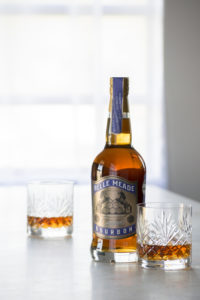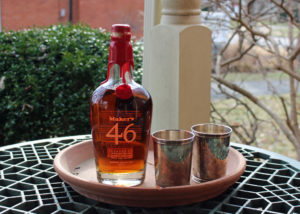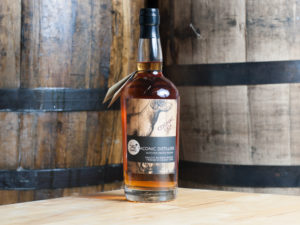Bourbon For Cognac Drinkers
By Richard Thomas

(Credit: Nelson’s Green Brier)
If you google up the title of this article, what you will find is a clutch of articles regarding cognacs, brandies and armagnacs for bourbon drinkers. What you won’t find (at least not on the first two pages) is a piece that actually addresses the question posed: what bourbons should you use as gifts or gateways for cognac drinkers?
The reason this subject is a one-way street is because bourbon is hot, way more people are into it or getting into it, and therefore the folks making cognac want bourbon drinkers to buy their stuff. However, I can tell you from person experience that just because this is where the strong current is going doesn’t mean it’s where everyone wants to swim. During my several years of living in Europe, I regularly found myself in the position of introducing fans of a wide variety of other spirits to American, Scotch and Irish whiskeys. Cognac isn’t even so forgotten that it needs a hashtag to remind people it exists, ala #MakeSherryCoolAgain; it is the tipple of choice for many. So, the question of what bourbons should you steer a cognac drinker seems neglected (but no longer!).
First, Cognac For The Bourbon Drinker
Cognac is a form of brandy from its particular region of France, and beyond the locality, the signature of this white grape spirit are its double-distillation in copper pots and the two years or more of aging it receives in new French oak. Most cognacs spend longer in the cask, sometimes much longer.
That new oak aging is what ties cognac to American whiskey, so much so that it’s often said the reason the earliest forerunners of American bourbon had appeal in the downriver markets of New Orleans was the new oak aging; the French colonists took to bourbon as a cognac-like spirit they could get locally.
Bourbon-makers will tell you that 40 to 80% of the flavor profile of their whiskey is down to barrel aging, which is to say the qualities of the barrel itself, how long it is used and where it is stored. The same is true of cognac, and here is where the qualities of the barrel become important, because one industry relies on a couple of distinct types of French oak and the other American white oak. As a rule, French oak influences the spirit aging inside it more slowly, and therefore with more subtlety, than American oak. Also, if you were to say American oak is heavy on vanilla and only somewhat spicy, French oak seems spicier because its flavors are more in balance. As the Cognac-Expert Blog wrote:
“These include the more common ones, such as vine flowers, toasted bread, vanilla, cinnamon, dried apricots, and candied fruits. And the less common (and therefore highly prized), such as chocolate, leather, port, toffee, and spices.”
Bourbons For Cognac Drinkers
One approach is to reach for bourbon that have been partly aged using French oak, leaning into cognac territory. There are a handful that draw either partly on French oak-aged whiskey for blending or use barrel inserts made from French oak. Buffalo Trace has released experimental whiskeys and a version of Old Charter that used new French oak for aging, but these were limited editions that became hard-to-get collectables as soon as they hit shelves. For something more obtainable, try:

(Credit: Richard Thomas)
Maker’s 46: For the purposes of approaching cognac-drinkers, what makes Maker’s 46 a prime choice is that the bourbon is finished (given a second spin of maturation) by inserting seared staves of new French oak into the barrels. The result is still identifiable as Makers’ Mark and wheated bourbon, but the French oak twist is unmistakable as well.
The other route is bourbon that has been given a finishing in an actual cognac casks, mingling cognac directly rather than relying on the source wood. The issue here is that these finishes are often limited edition releases, but some of them aren’t chased out of existence in the way the aforementioned Buffalo Trace bourbons were, and are still sometimes found on store shelves. This route also sometimes allows one to shop for a particular brand of cognac, whose casks were used in the finish.
A.D. Laws Four Grain Bourbon Cognac Cask Finish: This Colorado bourbon doesn’t start with the bonded bourbon that has generated no small amount of buzz lately, but instead is based on it’s younger, merely straight version. That received a cognac cask finish from an undisclosed source of cask stock. This is a limited edition release from the cask finish series of Laws Whiskey House, but

<(Credit: Taconic Distillery)
Belle Meade Cognac Finish Bourbon: Released as a limited edition in 2016, this is made with a blend of sourced high-rye, 6 to 9 year old bourbons and finished in Fine Champagne XO Cognac casks. Given that it is still on store shelves and available for the same price it was four years ago, it’s an educated guess that Nelson’s Greenbrier (who makes the Belle Meade brand from sourced whiskeys) has made at least one more batch since and will continue to do so as needed.
Taconic Dutchess Private Reserve Cognac Cask Bourbon: This is another sourced bourbon from a small distillery, Taconic, this time up in New York State. The source bourbon has a traditional mash bill this time (70% corn), and the cask stock comes from Remy Martin. It’s also younger than the Belle Meade creation, with a total of approximately four years in both casks combined. As Taconic Cognac Cask was released in 2019, examples should still be in distribution only a year later.



